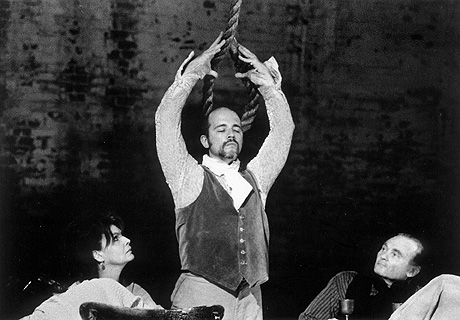| Rumours of War is a site-specific performance
in three parts conceived and directed by New Orleans performance
artist Kathy Randels
in collaboration with numerous local professional artists. An original
music score for the piece is composed by Sean LaRocca. Set
and costumes are designed by Shawn
Hall. The piece, which was produced by ArtSpot Productions
and The University of New Orleans Women's Center with support
from the Contemporary Arts Center's Performance Support Program,
premiered at the Contemporary Arts Center's performance garage October
19-28, 2001. Subsequently, the piece was performed at Magdalena
Pacifica, and International Festival of Women in Theatre
in Cali, Colombia, in September 2002.
 Rumours of War is set on a Louisiana plantation
at the beginning of the 19th century. In part one, War, Lucas
Cox portrays a revolutionary abolitionist from the North who has
come to his uncle's house for the summer with the intention of aiding
in the planning and execution of a slave revolt. While there, he
falls in love with his uncle's wife, the mistress of the house.
The master of the house, played by John Hammons, is a general in
the federal army, and has been away at the capital for several weeks.
The general's son, played by J
Hammons, is holding a dinner party on this evening. After
the escalation of a fight between the abolitionist and the son over
the mistreatment of a house slave, played by Roscoe Reddix, Jr.,
the abolitionist and the slave murder all of the guests at the party.
As the sole survivor of the massacre, the son limps to the capital
to retrieve his father. War, which is set in the dining room
of the main house, explores the individual minds of those driven
to fight, and the larger societal problems that provoke wars. Additional
source material for this section comes from speeches of U.S. presidents
and military leaders, and from oral histories of veterans and war
survivors currently living in New Orleans that were collected by
local public high school students involved in the Students at the
Center programs at McDonogh 35 and Abramson high schools.
Rumours of War is set on a Louisiana plantation
at the beginning of the 19th century. In part one, War, Lucas
Cox portrays a revolutionary abolitionist from the North who has
come to his uncle's house for the summer with the intention of aiding
in the planning and execution of a slave revolt. While there, he
falls in love with his uncle's wife, the mistress of the house.
The master of the house, played by John Hammons, is a general in
the federal army, and has been away at the capital for several weeks.
The general's son, played by J
Hammons, is holding a dinner party on this evening. After
the escalation of a fight between the abolitionist and the son over
the mistreatment of a house slave, played by Roscoe Reddix, Jr.,
the abolitionist and the slave murder all of the guests at the party.
As the sole survivor of the massacre, the son limps to the capital
to retrieve his father. War, which is set in the dining room
of the main house, explores the individual minds of those driven
to fight, and the larger societal problems that provoke wars. Additional
source material for this section comes from speeches of U.S. presidents
and military leaders, and from oral histories of veterans and war
survivors currently living in New Orleans that were collected by
local public high school students involved in the Students at the
Center programs at McDonogh 35 and Abramson high schools.
 The
second part, Lullaby, takes place in a field far from the
main house. One of the slaves, a high priestess of the Yoruba religion,
has been asked by the gods to sacrifice her only daughter to ascertain
a successful revolt. Lullaby is a danced duet for two women:
renowned local dancers Ausettua Amor Amenkum and Monique Moss. Ms.
Amenkum's extensive knowledge of and skills in traditional African
Dance and Ms. Moss' excellence in modern dance forms are contrasted
in this piece to reveal the battle between generations, between
tradition and progress, and ultimately how the individual's relationship
to God has been a source of violence towards fellow man since the
beginning of human existence. The legend of the dance by a Voodoun
Priestess that sparked the Haitian Revolution in the late 18th century
is one of the inspirations for this piece, as well as: the story
of Abraham and Isaac from the Bible; Beloved, by Toni Morrison;
and Fear and Trembling, by Søren Keirkegaard. The
second part, Lullaby, takes place in a field far from the
main house. One of the slaves, a high priestess of the Yoruba religion,
has been asked by the gods to sacrifice her only daughter to ascertain
a successful revolt. Lullaby is a danced duet for two women:
renowned local dancers Ausettua Amor Amenkum and Monique Moss. Ms.
Amenkum's extensive knowledge of and skills in traditional African
Dance and Ms. Moss' excellence in modern dance forms are contrasted
in this piece to reveal the battle between generations, between
tradition and progress, and ultimately how the individual's relationship
to God has been a source of violence towards fellow man since the
beginning of human existence. The legend of the dance by a Voodoun
Priestess that sparked the Haitian Revolution in the late 18th century
is one of the inspirations for this piece, as well as: the story
of Abraham and Isaac from the Bible; Beloved, by Toni Morrison;
and Fear and Trembling, by Søren Keirkegaard.
 In
part three, The White Woman of the West, Kathy
Randels portrays the mistress of the plantation, who
is on her deathbed. This section plays out the war within the body
of a woman infected with cancer. Randels began creating this piece
in June 1999. Initial excerpts were performed at The Breeding Ground,
an international festival for women in performance in Cardiff, Wales
in October 1999, that focused on the role of the artist during wartime.
The character's race symbolizes her position of privilege in a capitalist
society that exploits land and labor inside and outside its borders.
She enjoys her privilege, knowing that others have died and continue
to die for it. She is also the most intimate victim of her husband's
brutality. This dichotomy-this contradiction-is the heart of her
cancer. The audience witnesses her as she nears death. The text
for The White Woman of the West is written by Kathy Randels. In
part three, The White Woman of the West, Kathy
Randels portrays the mistress of the plantation, who
is on her deathbed. This section plays out the war within the body
of a woman infected with cancer. Randels began creating this piece
in June 1999. Initial excerpts were performed at The Breeding Ground,
an international festival for women in performance in Cardiff, Wales
in October 1999, that focused on the role of the artist during wartime.
The character's race symbolizes her position of privilege in a capitalist
society that exploits land and labor inside and outside its borders.
She enjoys her privilege, knowing that others have died and continue
to die for it. She is also the most intimate victim of her husband's
brutality. This dichotomy-this contradiction-is the heart of her
cancer. The audience witnesses her as she nears death. The text
for The White Woman of the West is written by Kathy Randels.
The entire piece has been in process since October
2000 with support from the Leanne Knot Violence Against Women
Prevention Project and grants from the Louisiana State Arts
Council through the Louisiana Division of the Arts and
the National Endowment for the Arts and The Fund for U.S.
Artists at International Festivals and Exhibitions.
|


 Rumours of War is set on a Louisiana plantation
at the beginning of the 19th century. In part one, War, Lucas
Cox portrays a revolutionary abolitionist from the North who has
come to his uncle's house for the summer with the intention of aiding
in the planning and execution of a slave revolt. While there, he
falls in love with his uncle's wife, the mistress of the house.
The master of the house, played by John Hammons, is a general in
the federal army, and has been away at the capital for several weeks.
The general's son, played by
Rumours of War is set on a Louisiana plantation
at the beginning of the 19th century. In part one, War, Lucas
Cox portrays a revolutionary abolitionist from the North who has
come to his uncle's house for the summer with the intention of aiding
in the planning and execution of a slave revolt. While there, he
falls in love with his uncle's wife, the mistress of the house.
The master of the house, played by John Hammons, is a general in
the federal army, and has been away at the capital for several weeks.
The general's son, played by  The
second part, Lullaby, takes place in a field far from the
main house. One of the slaves, a high priestess of the Yoruba religion,
has been asked by the gods to sacrifice her only daughter to ascertain
a successful revolt. Lullaby is a danced duet for two women:
renowned local dancers Ausettua Amor Amenkum and Monique Moss. Ms.
Amenkum's extensive knowledge of and skills in traditional African
Dance and Ms. Moss' excellence in modern dance forms are contrasted
in this piece to reveal the battle between generations, between
tradition and progress, and ultimately how the individual's relationship
to God has been a source of violence towards fellow man since the
beginning of human existence. The legend of the dance by a Voodoun
Priestess that sparked the Haitian Revolution in the late 18th century
is one of the inspirations for this piece, as well as: the story
of Abraham and Isaac from the Bible; Beloved, by Toni Morrison;
and Fear and Trembling, by Søren Keirkegaard.
The
second part, Lullaby, takes place in a field far from the
main house. One of the slaves, a high priestess of the Yoruba religion,
has been asked by the gods to sacrifice her only daughter to ascertain
a successful revolt. Lullaby is a danced duet for two women:
renowned local dancers Ausettua Amor Amenkum and Monique Moss. Ms.
Amenkum's extensive knowledge of and skills in traditional African
Dance and Ms. Moss' excellence in modern dance forms are contrasted
in this piece to reveal the battle between generations, between
tradition and progress, and ultimately how the individual's relationship
to God has been a source of violence towards fellow man since the
beginning of human existence. The legend of the dance by a Voodoun
Priestess that sparked the Haitian Revolution in the late 18th century
is one of the inspirations for this piece, as well as: the story
of Abraham and Isaac from the Bible; Beloved, by Toni Morrison;
and Fear and Trembling, by Søren Keirkegaard.  In
part three, The White Woman of the West,
In
part three, The White Woman of the West,